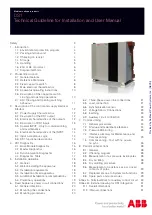
13
Pressure Monitoring is performed by a pressure switch with
two thresholds: 4.1 bar (absolute) and 3.7 bar (absolute)
The maximum absolute ratings for the contacts are:
Voltage
Resistive Load (cos(fi)=1) Inductive Load (cos(fi)=0.6 – 0.7)
125 VAC
3A
2A
250 VAC
3A
2A
30 VDC
3A
2A
125 VDC
0.4A
0.05A
Table 3. Pressure sensor output characteristics
Note
: In the DC current condition the time constant must be
less than 7ms for inductive loads.
DS1 Position Sensing
the (Close/Open) indication is given by
dry contacts.
The recommended operating conditions are summarized be-
low:
Position Switch Electrical Characteristics
Rated Insulation Voltage
AC 380V
Rated Operating Voltage
AC DC 250V
Rated Operating Current
AC 250V/16A; DC 250V/0.3A
Power Frequency withstand Voltage 2000 VAC
Contact Resistance
<=30mOhm
Table 4. Position Sensing output characteristics
If the installation requires higher current, an auxiliary relay can
be used in order to replicate the contact and perform higher
current capability.
3.4 Description of DS1 inputs
The following input signals can be transmitted to DS1 in order
to provide the required operations.
−
Open
(DS1 is requested to perform an Open operation when
the switch is closed)
−
Close
(DS1 is requested to perform a Close operation when
the switch is open)
Additional inputs are installed in order to provide additional
control features as follows:
−
Interlock
(prevents DS1 from operating when the interlock
loop is open)
The Interlock circuit is used by the control system logic to pre-
vent operation when this circuit is open. The standard DS1
internal cabling opens the interlock circuit when the pressure
reaches its minimum value. You are strongly advised to coor-
dinate the interlock hierarchy according to substation interlock
requirements (opening of the interlock loop when DS1 must be
prevented from operating).
Since DS1 does not allow fault making and fault breaking
events, you are also strongly advised to ensure safe coordina-
tion of the interlock circuit when:
− the upstream CB is operated (requested by control room OR
protection fault TRIP)
− when the downstream earth switch is closed.
In both the above situations, you are strongly advised to coor-
dinate the interlock function in order to open the interlock loop
and prevent DS1 from operating.
3.5 Special INPUT- Only for commissioning
and maintenance
A special input is installed for the purpose of providing special
control features:
Upstream CB Interlock
Special inputs are installed in order to provide special control
features during commissioning or maintenance.
Homing
DS1 only controls the position of the power part when this is,
within certain limits, in the Closed or Open Condition. A Hom-
ing command can be provided when, during maintenance or
commissioning, the position of the switch is not in the Open or
Closed position. DS1 will process the request and initialize its
position in the Open condition. The homing command is only
processed when the upstream CB Interlock is provided (the MV
bus bar are de-energized).
Reset
DS1 is equipped with an advanced diagnostic runtime. Its sta-
tus is continuously monitored both when DS1 is Idle (operating
condition waiting for a command) and operating.
When an alarm event TRIPS (something wrong has happened
during operation), DS1 completes the requested operation and
then sets to the Alarm status.
If this occurs, it is advisable to stop all operations and call
ABB’s representative for assistance.
The upstream CB Interlock is an input
that is only used for maintenance or
commissioning. Excitation allows DS1 to
operate without synchronization in order
to perform CO sequences without MV
power on the bus bars.
Excitation of this input when MV is
supplied is absolutely forbidden since DS1
will operate without synchronization and
its integrity could be compromised.
Please refer to the commissioning proce-
dure for details.
Provided
by
Northeast
Power
Systems,
Inc.
(NEPSI)




























